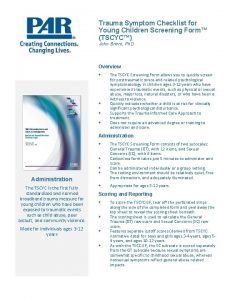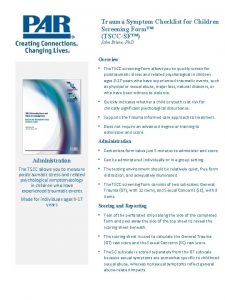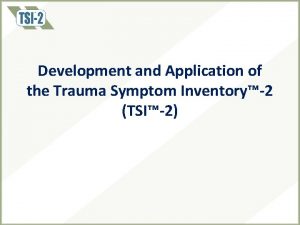Trauma Symptom Checklist for Young Children Screening Form


- Slides: 2

Trauma Symptom Checklist for Young Children Screening Form™ (TSCYC™) John Briere, Ph. D Overview The TSCYC Screening Form allows you to quickly screen for posttraumatic stress and related psychological symptomatology in children ages 3 -12 years who have experienced traumatic events, such as physical or sexual abuse, major loss, natural disasters, or who have been a witness to violence. Quickly indicates whether a child is at risk for clinically significant psychological disturbance. Supports the Trauma Informed Care Approach to treatment. Does not require an advanced degree or training to administer and score. Administration The TSCYC is the first fully standardized and normed broadband trauma measure for young children who have been exposed to traumatic events such as child abuse, peer assault, and community violence. Made for individuals ages 3 -12 years The TSCYC Screening Form consists of two subscales: General Trauma (GT), with 12 items, and Sexual Concerns (SC), with 8 items. Carbonless form takes just 5 minutes to administer and score. Can be administered individually or a group setting. The testing environment should be relatively quiet, free from distraction, and adequately illuminated. Appropriate for ages 3 -12 years. Scoring and Reporting To score the TSCYC-SF, tear off the perforated strips along the side of the completed form and peel away the top sheet to reveal the scoring sheet beneath. The scoring sheet is used to calculate the General Trauma (GT) raw score and Sexual Concerns (SC) raw score. Features separate cutoff scores (derived from TSCYC normative data) for boys and girls ages 3 -4 years, ages 59 years, and ages 10 -12 years. As with the TSCC-SF, the SC subscale is scored separately from the GT subscale because sexual symptoms are somewhat specific to childhood sexual abuse, whereas nonsexual symptoms reflect general abuse related impacts.

Reliability, Validity, and Norms Normative data (N = 750) features caretaker reports of children ages 3 -12 years. Internal consistency coefficients are in the good-to-excellent range. Test-retest reliability was r =. 80 (p <. 001) for each scale.


